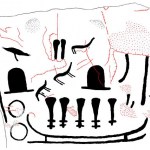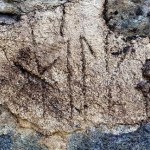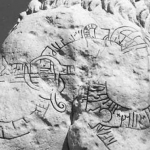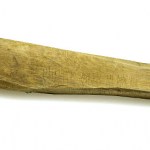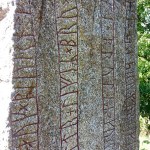runes
The new version of a slab from the Kivik cairn.
Fornvännen 2015:1 is now on-line on Open Access.
Sven Sandström on fake Paleolithic art in France.
Andreas Toreld and Tommy Andersson on sensational new discoveries on the carved slabs of the Kivik burial cairn. They've been endlessly discussed for over 200 years, and now the whole game just changes.
Birgit Maixner on a new Late 1st Millennium elite site at Missingen/Åkeberg in Norway.
Inger Jans et al. on the last users of runes in the unbroken tradition from the Iron Age on – around 1910!
Anders Söderberg on one of these lovely little…
This year's first week of fieldwork at Stensö Castle went exceptionally well, even though I drove a camper van belonging to a team member into a ditch. We're a team of thirteen, four of whom took part in last year's fieldwork at the site. All except me and co-director Ethan Aines are Umeå archaeology students. We're excavating the ruin of a castle that flourished in the 13th and 14th centuries. This year we have a very nice base at Smedstad, let to us by the genial B&B host Hans-Ola. But we cook our own meals, each day having its designated cooks and dishwashers, and in the evenings we…
The Lion of Pireus is a large 4th century BC marble statue that was moved from Pireus, the port of Athens, to Venice in 1688. It is now at the city's Arsenal. The Lion has unmistakeable Swedish 11th century runic inscriptions which have been known to Scandinavian scholars since 1798/99. Clearly they have something to do with the Varangian Guard, Swedish soldiers in the employ of the Byzantine Emperor from the 980s onward. But due to poor preservation, the message carried by those runes has been believed lost.
There is a cast of the Lion at the Historical Museum in Stockholm, and I've often…
We interrupt this transmission for a puerile message from Medieval Bergen. It was found carved with runes on a stick at the Hanseatic docks.
ion silkifuþ a mek en guþormr fuþcllæikir ræist mik en : ion fuþkula ræþr m(e)k (N B434)
“John Silkencunt owns me and Guttorm Cuntlicker carved me and John Cuntball reads me”
Philologists are not certain as to whether fuþkula, “cuntball”, means clitoris, or a well-padded mons veneris, or “cunt cavern”. All the three mentioned men are historical figures known from other sources, but apparently they are usually referred to there as John Silk, Guttorm…
The Stone of Sälna is a runestone (U 323) erected about AD 1000 at Sälna hamlet where a major road crossed Hargsån stream in Skånela parish, Uppland. (This is not far from where Arlanda airport now sprawls.) None of this is unusual. But the stone's great height, its inscription and its later fate are. Here's what can be made out of the runes as they survive today and as documented by a 17th century antiquarian.
Østeinn and Jorundr and Bjorn, the brothers, erected [this] stone [after] ...steinn drums, their father. God help his spirit and soul, forgive him his crimes and sins. Forever shall…
My paper on the re-use of Late Iron Age picture stones during that same period (mainly in late male graves) has been published in English and Swedish parallel versions of Gotländskt Arkiv 2012. That's the annual of the Gotland County Museum. Have a look! Questions and comments are most welcome.
Here's an extremely useful resource. The Swedish National Heritage Board has scanned the great multivolume corpus publication of Swedish runic inscriptions, Sveriges runinskrifter, and put it on-line for free. Currently as PDF files, but in the future there will also be a structured database. Though the PDF:s have been run through optical character recognition, they don't seem to have been indexed on Google (yet?).
For an example, read about (p. 547 ff) Kalv's runestone U 875 at Focksta in Hagby, Uppland, shown above.
I've written before about the archaeological landscape surrounding Arlanda International Airport north of Stockholm. Following on yesterday's post about the fake archaeology in Oslo airport, here's a piece of landscape that has been moved inside Arlanda's terminal 2. It's an 11th century runestone commemorating one of the men who died on Ingvar the Far-travelled's disastrous expedition to the east. The stone was found in 2000 when the road to the airport was widened, suggesting an impressive age for the road. Placing the runestone in the airport terminal ensures its protection from the rain…
The Kensington runestone of Minnesota is a rather obvious 19th century fake. But in a recent paper in Saga och Sed 2010, Mats G. Larsson shows something less obvious: the hidden signature of the stone's carver, who also was its finder.
Olof Ãhman came from Forsa in Hälsingland, central Sweden. He claimed to have found the stone among the roots of an aspen tree he had felled with his son. Now Larsson points to the unique rune for à on the stone, which is an O with a small N inside. This looks a lot like O-n, an abbreviation of the man's surname. And as it turns out, Ãhman came from a…
If we look only at contemporaneous written evidence and disregard kings, Iarlabanki Ingefastson is probably the most copiously documented Scandinavian of the Viking Period. But his name does not occur even once on vellum. His memory lives entirely in the many rune stones he commissioned.
Iarlabanki (Jarlabanke in modern Swedish) was a major landowner in Uppland north of Stockholm, and his lifetime happened to coincide with the great mid-to-late-11th century rune stone craze in that province. Iarlabanki was a Christian, probably only of the third generation, and like other monuments of the…
Driving through Hagby parish in Uppland on a tiny road Friday, I was lucky enough to cross the bridge at Focksta right at the moment when the afternoon sun hit this lovely runestone straight on. I didn't even have to get out of the car to take the photograph.
Dating from the early 11th century, the stone is an unsigned work of Ãsmund KÃ¥resson (U 875). It's unusual in that it has a couple of Bronze Age cupmarks too. The inscription reads, "Tyrvi and Ingegärd and Tjälve had this stone erected after Kalv, Tyrvi's husband. May God and God's mother help his spirit."
Note the cross and the…
The recently found Norwegian 5th century runestone of Hogganvik carries a memorial inscription and so might be expected to have stood on or near a grave. My buddy Frans-Arne Stylegar has excavated the site and sadly found no preserved burial, but he did find the original stone setting of the monument. This is a rare kind of knowledge, as many runestones have been moved around through the centuries. Now the runestone stands again, the site has been cleaned up, and the public is free to come see the most important early runic document to surface in many decades.
Photograph by Frans-Arne…
Runologist James E. Knirk has published a report on the recently found Hogganvik rune stone. His transliteration is
[?]kelbaþewas:s(t)^ainaR:aaasrpkf
aarpaa:inanana(l/b/w)oR
eknaudigastiR
ekerafaR
His translation is
Skelba-þewaR's ["Shaking-servant's"] stone. (Alphabet magic: aaasrpkf aarpaa). ?Within/From within the ?wheel-nave/?cabin-corner. I NaudigastiR [="Need-guest"]. I, the Wolverine.
So there isn't actually an explicit lord-retainer relationship in the text, just a guy whose name includes the word for servant, thewar. It also occurs in two names inscribed on weaponry from Danish…
Most rune stones are written with the late 16-character futhark and date from the 11th century when the Scandies had largely been Christianised. Their inscriptions tend to be formulaic: "Joe erected the stone after Jim his father who was a very good man". But by that time, runic writing was already 900 years old. It's just that inscriptions in the early 24-character futhark are much less common. And when you find them, their messages are usually far less straight-forward.
My buddy Frans Arne Stylegar reports in a series of blog entries [1 - 2 - 3 - 4 - 5] on the discovery, less than two…
In Nazi Germany and its occupied territories there were many ways to get thrown into an extermination camp. But Friedrich Marby broke some kind of record: he was sent to Dachau for publishing too silly ideas about runes. He survived.
The Nazis themselves were no strangers to occultism, particularly Heinrich Himmler, whose neo-Pagan religious movement I've touched upon before. Movements similar to today's New Age, neo-paganism and occultism flourished in the early 20th century. But Marby was too much even for Himmler: he invented runic aerobics.
Marby's ideas took off from the cosmic and…
Here's a fun project. Maja Bäckvall and Jannie Teinler with friends are visiting rune stones mainly in Uppland province, posing for photographs along with the stones and publishing them on a dedicated web site. So far they've done 121 rune stones!
Högby near Mjölby in Ãstergötland is a magical place because of a serious lack of historical sensitivity. In 1876 (which is really late as these things go in Sweden) the locals demolished their little 12th century church and built a new bigger one a mile to the south. This meant that the parish centre of a millennium or so became a backwater and has not been built over later. It's completely rural, abutting a farm's back yard, very quiet. All that remains of the church is the churchyard wall and one of Ãstergötland's finest rune stones that was taken out of the sacristy wall. Some fine…
From about 1845 to 1930, Sweden saw massive emigration to the United States. According to one estimate, about a third of the country's population left. In 1900, more Swedes lived in Chicago than in Gothenburg. Many factors conspired to send people on their way: population expansion, a lack of agricultural land, failed crops, economic recession, and the simple pull of the virtual population vacuum beyond the American frontier, the pull of enormous opportunity, as industrialised Europeans encountered the Stone Age societies of the native Americans.
The emigration left its share of…
[More blog entries about archaeology, runes, Minnesota, kensington, middleages; arkeologi, runor, medeltiden, usa.]
The Kensington runestone is a 19th century fake from Minnesota. It purports to be a monument left behind by a Scandinavian expedition in the 14th century, but uses anachronistic turns of phrase and runic characters typical of 19th century popular culture. The runestone is nevertheless touted as authentic by enthusiastic local amateur scholars.
"8 Geats and 22 Norwegians on acquisition venture from Vinland far to the west We had traps by 2 shelters one day's travel to the north…
